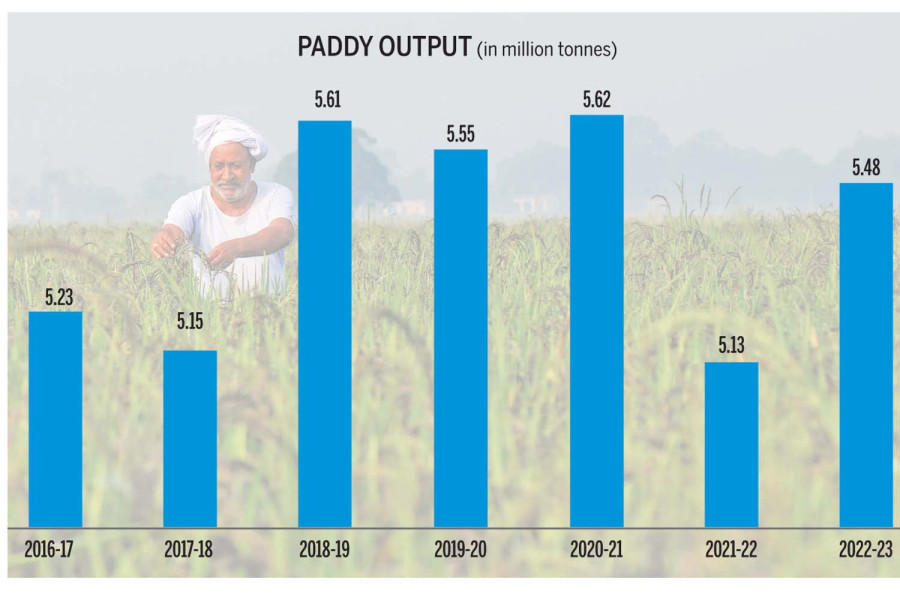Money
Farmers likely to harvest 5.48 million tonnes of paddy
The paddy harvest will produce 3.52 million tonnes of rice after milling while Nepal requires 4 million tonnes annually to feed its population.
Sangam Prasain
Nepali farmers are expected to harvest 5.48 million tonnes of paddy this fiscal year, which is 7 percent more than last year, despite a crippling shortage of chemical fertiliser during the key transplantation period in the monsoon.
The growth in paddy output may give some respite to the Pushpa Kamal Dahal-led administration as the country’s economy is struggling amid a high inflation rate. Experts say a good harvest checks inflation and energises the economy.
The paddy harvest will produce around 3.52 million tonnes of rice after milling. Nepal requires 4 million tonnes of rice annually to feed its population, and there could be a deficit of 480,000 tonnes this fiscal year, the Agriculture Ministry said on Thursday. The shortfall is normally met by imports from India.
Nepal's ever-swelling agricultural imports hit the Rs400 billion mark in the last fiscal year, prompting experts to warn that a farming country becoming so dependent on imported food indicates a full-blown emergency.
The value of cereal imports in the last fiscal year came to Rs74.28 billion. Out of the total shipments, rice and paddy amounted to Rs29 billion and Rs16.99 billion, respectively.
Even though output has risen, it is still at a five-year low.
The Ministry of Agriculture and Livestock Development said in its preliminary paddy production forecast that improved varieties and mechanisation had helped to boost productivity.
“Paddy productivity has increased by 10 percent,” said Prakash Kumar Sanjel, spokesperson for the ministry. “Clearly, there was a severe shortage of chemical fertiliser during the transplantation period, but farmers have reported that they got by because smuggled stock was available.”
Paddy is transplanted across most of Nepal in June and harvested in October. It is Nepal’s biggest earning farm commodity, with tens of thousands of farmers relying on it for their livelihood. The country’s economy also depends on its paddy production.
Nepal recorded a historic high paddy harvest of 5.62 million tonnes in 2020-21 as it had a surplus of farmhands with hordes of migrant workers returning home amid Covid lockdowns. Adequate fertiliser supplies and a good monsoon helped farmers to produce a bumper harvest.
But paddy output shrank in the following year.
In 2021-22, the harvest dropped 8.74 percent year-on-year to 5.13 million tonnes due to unseasonal October rainfall. The downpours damaged paddy crops worth Rs8.26 billion, the highest losses on record, according to the ministry's report.
Nepal’s economic wellbeing is intimately linked to the rainy season. Water from the skies is the lifeblood of Nepal's Rs4.85 trillion economy which is farm-dependent, as nearly two-thirds of the farmlands are rain-fed.
According to the ministry, the contribution of paddy to the country’s gross domestic product amounts to 4 percent.
The ministry said that the per capita cereal requirement in Nepal is 181 kg. Of the total cereal requirement, rice should make up 121 kg. But as Nepalis appear to be ardent rice eaters, the per capita rice requirement is 137 per kg.
Nepali farmers have been facing a shortage of chemical fertiliser every year. Nepal suffered the worst chemical fertiliser shortage during the June-August paddy transplantation season.
Farmer Karna Bahadur Thapa of Rangeli, Morang, told the Post in a recent interview that he used smuggled chemical fertiliser this year, but in small quantities, as there was not a grain of fertiliser in the government depots.
Thapa said he produced 110 maund (around 40 kg) on a bigha (0.67 hectares) this year as he applied an improved variety of paddy. He was ecstatic at having grown a bumper crop even without applying a sufficient amount of chemical fertiliser.
Government statistics show that the import of chemical fertiliser plunged by more than half in the last fiscal year following a fivefold jump in prices.
The import of chemical fertiliser in the last fiscal year stood at 215,000 tonnes, down from 378,000 tonnes in the previous fiscal year. Before that, the annual import of chemical fertilisers used to be nearly 450,000 tonnes.
Even though shipments were down, the fertiliser import bill crossed Rs22 billion, the highest amount on record.
According to spokesperson Sanjel, they have asked for an additional Rs8 billion on top of the Rs16 billion budget allocated for fertiliser imports to buy another 90,000 tonnes of urea this fiscal year.
“We have estimated there will be a deficit of 90,000 tonnes of urea during this summer paddy season.”
According to him, the first consignment of 30,000 tonnes of urea under the Nepal-India government-to-government arrangement may arrive soon.
According to the ministry, Madhesh province is the largest producer of paddy with the annual harvest projected to reach 1.38 million tonnes, followed by Province 1 (1.33 million tonnes), Lumbini (1.15 million tonnes), Sudurpaschim (589,221 tonnes), Bagmati (500,446 tonnes), Gandaki (391,121 tonnes) and Karnali (129,473 tonnes).
In terms of productivity, Province 1 tops the list with 4.02 tonnes per hectare, followed by Bagmati (3.84 tonnes per hectare) and Lumbini (3.81 tonnes per hectare). Paddy productivity of Madhesh province is 3.70 tonnes per hectare followed closely by Gandaki with 3.68 tonnes per hectare.




 19.12°C Kathmandu
19.12°C Kathmandu













%20(1).jpg&w=300&height=200)
